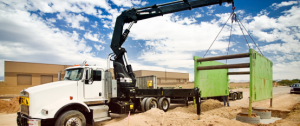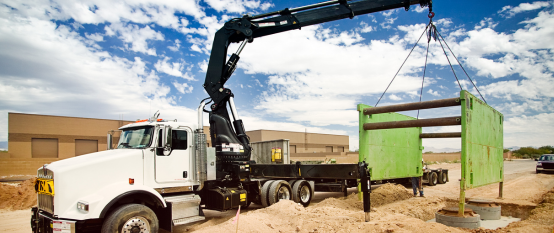
If you’re looking to diversify your driving experience and stand out to employers, becoming a boom truck operator might be the right move for you. This unique driving position requires an additional training certification, but often results in increased pay and a wider variety of available jobs.
Boom trucks are used in a range of industry settings, and can be a great investment if you’re looking to own and operate your own truck. The certification process only takes a few hours and is widely available online. Keep reading to learn everything you need to know before becoming a boom truck operator, so you can decide if it’s the right choice for you.
What is a Boom Truck?
By definition, a boom truck is a commercial truck with a hydraulic crane attached to its chassis. There are many variations on this basic structure that enable boom trucks to be useful for a range of different jobs. The two primary types of truck are fixed cab and swing cab vehicles, which are classified depending on the mobility and positioning of the cabin.
A fixed cabin boom truck will contain one cab with all of the controls for the crane. This means that these trucks operate much like a standard truck, allowing them to have a smaller size that can make maneuverability easier.
There are also downsides to a stationary cab, including visibility issues. This is where a swing cab boom truck comes into play. With a longer structure, these trucks have a separate cab for the operator which offers better visibility and flexibility when lifting. Swing cabs are often favored by construction companies, since they are better for more intricate jobs.
Which Boom Truck is Right for You?
Beyond the two primary types of boom truck, there are a few other variations. It’s important to know the different kinds of boom trucks so you can choose the right one for you.
Sometimes referred to as a boom truck crane or a boom crane, this type of truck has a telescopic arm and usually works similar to a typical crane to lift and move heavy objects between 10 and 60 tons.
Another type of boom truck is an articulating lift, which is helpful in jobs where precision is important. Due to the joint in the extension, these trucks are designed to be lightweight and able to maneuver while working in tight spaces.
If your jobs call for lifting people, instead of heavy loads, then a bucket truck is the right choice for you. These trucks are designed with a rising platform where technicians can stand and work while keeping their tools close by. Most bucket trucks have some sort of wall or railing for safety, and some newer trucks are built with a fiberglass cabin to further improve worker safety.
Flexibility, experience, and having the ability to develop new skills are all extremely important in the career of every truck driver. In today’s competitive market, it is more important than ever to stand out to employers by increasing your marketable talents. Being able to drive specialized vehicles, such as boom trucks, is a great way to differentiate yourself from your competition and increase the scope of jobs for which you are qualified.
Although driving a boom truck requires its own certification, plenty of companies will make it worth the effort with incentives and bonuses for having this skill.
Here at Drive My Way, we’re always looking to find and promote tools that could be beneficial to any trucker. Read more from our Driver Blog to learn essential tips and resources, and be sure to reach out to us on social media if there’s anything we missed!





